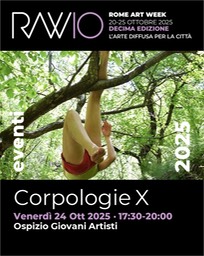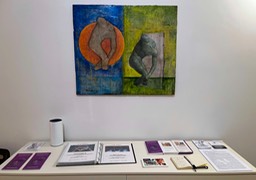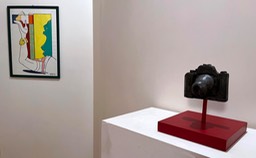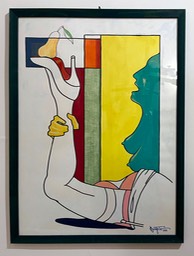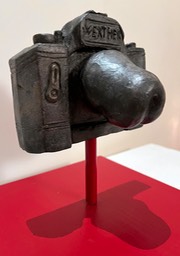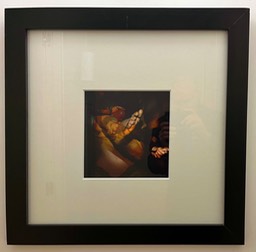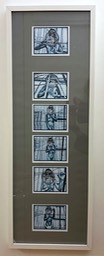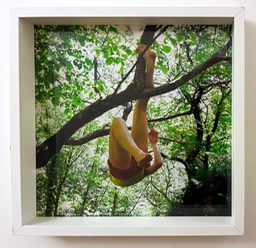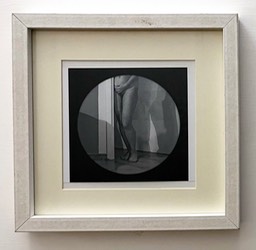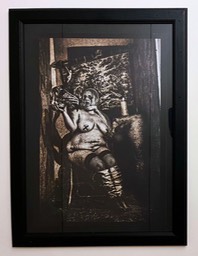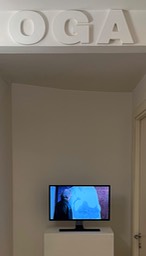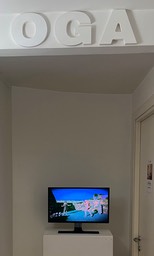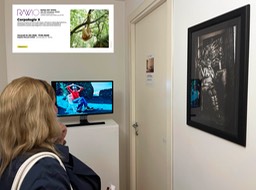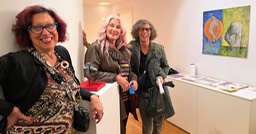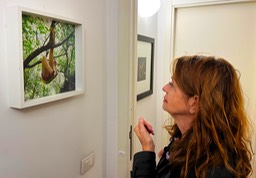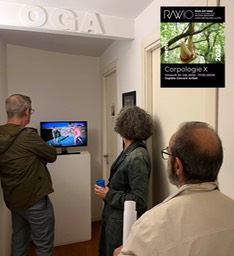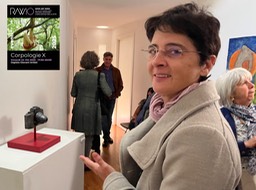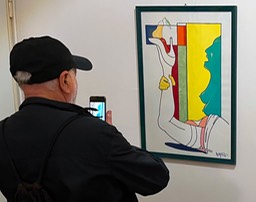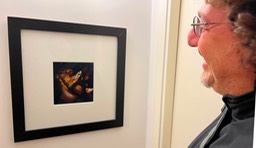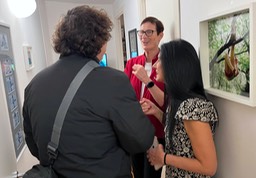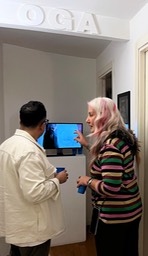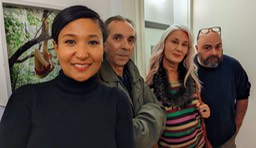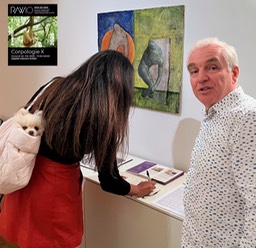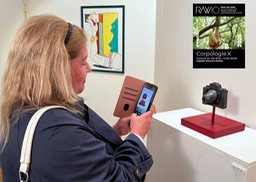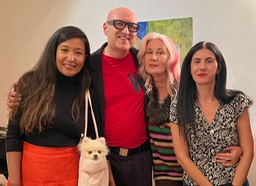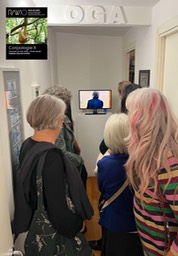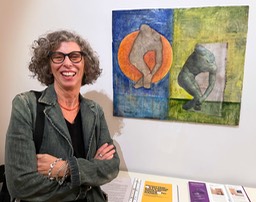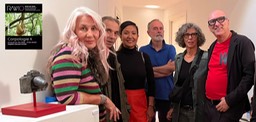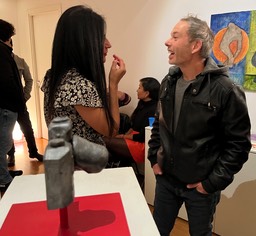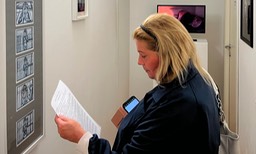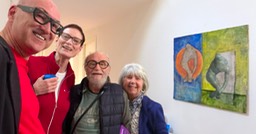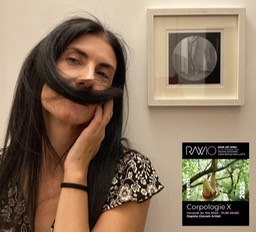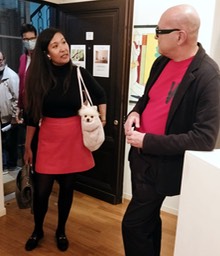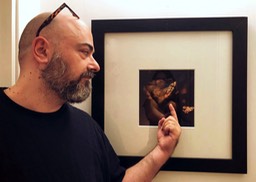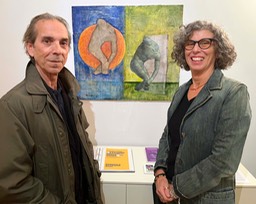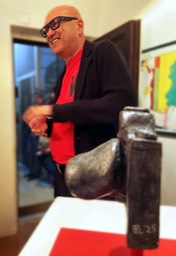Artists: Antonella Albani, Paola Alviano Glaviano, Salvatore Attanasio Avitabile, Andy Flipegg, Michael Knoten, Werther Germondari, Gulia Lusikova, Florindo Rilli, Silvia Marcantoni Taddei, Mario Tarantino.
Tenth exhibition on the theme of the body, within the (S)exhibitions, analyzed once again in its infinite possibilities of social, psychological and naturally aesthetic interaction, through the works of ten international artists, part as always of the OGA Collection.
Antonella Albani (Roma, Italy, 1972). After graduating in Applied Arts with a specialization in "Artistic Photography" and "Advertising Graphics", she graduated with honors in "History of Modern Art" at La Sapienza University, with a thesis on Raphael's legacy in Western painting. Her works tell of the expectation of something that will never happen. The action of her characters moves around a suspension, the latter are often immobile, crystallized. It is a photograph tinged with metaphysics and at times ironic surreality, which often denounces a loneliness, especially of the female figure.
Salvatore Attanasio Avitable (Plan of Sorrento, Italy, 1972). Artist for three generations, his artistic destiny is already marked in the first months of his life! He will later remember an episode that happened when he could neither speak nor walk; in his white cradle illuminated by the soft light of the afternoon, his gaze rests on a painting by the painter's aunt, and he recognizes in the figures a very sad motherhood, the painted face of the mother is bitter, the child seems dead, the two figures sink into a black backdrop, impressed Salvatore reacts in the only way he knows, and cries in fear. From that moment on, art enters his life and will never leave him again.
Andy Flipegg (Latina, Italy, 1979) spent his childhood in Naples and then moved to Rome where he still lives and works today, oscillating between a porn film operator and a passion for erotic photography. In his works the vision of the bodies begins to mix details and sensations, eroticism and pornography, trying to give off an erotic sensation at the limit of the explicit.
Paola Alviano Glaviano (Roma, Italy, 1962) she graduated in 1980 from the I Liceo Artistico in Via di Ripetta; later, while attending the faculty of Architecture and the Scuola Libera del Nudo, she deepened her interest in the human body, which will play a significant role in her career as a painter. The constant search for new techniques evolves quickly, from the brush to the spatula, from color to black and white and then back to polychromy and again to monochrome with the use of bitumen. From jute canvas and subsequently to cardboard, which represents her current phase.
Werther Germondari (Rimini, Italy, 1963) Visual artist, performer and filmmaker. Interested in innovative experimental dynamics that are neo-conceptual and situational, characterized by a taste for the ironic and surreal, Germondari has experimented for 40 years through many different expressive media (painting, installations, photography, film, videos, live performance). Germondari's works have also been shown in solo exhibitions where he focuses on hidden elements highlighted in styles. In 2013 he founded the OGA.
Micheal Knoten (Fratiskovy Lazne, Czech Republic, 1984) works as a laborer in metal production. He has devoted himself to artistic creation since childhood. "In the course of my life, inspired by my surroundings, I began a sincerely misanthropic artistic path, exploring the dark sides of the human soul." For more than ten years, he has devoted himself to digital photography and graphic design, following the principles of pictorialism. He has had many solo exhibitions, and has many audiovisual collaborations for extreme metal bands to his credit.
Gulia Lusikova (Minsk, Belarus, 1967) is a graduate of the Academy of Fine Arts in Minsk. After an intense artistic activity in the former Soviet Union, where Gulia was a member of the avant-garde group BLO in Minsk and exhibited several times at the St. Petersburg gallery Pushkinskaya 10. He then participated in exhibitions in France and Germany. He moved to Rome in 1993 and began collaborating with the Pio Monti, Nuova Pesa and Matteo Boetti Galleries and with various critics. In conjunction with his daughter Karolina, he participated in the 14th Quadriennale in Rome.
Silvia Marcantoni Taddei (Genova, Italy, 1994) is a multimedia/multidisciplinary artist. In 2019 she launched the project AnimaeNoctis with her husband Massimo Sannelli (1973): a roaming duo dealing with post-porn art, filmmaking, photography+modeling, e-publishing, video/dance, video/performance, music. Silvia decided to change her life after years of severe depression, anxiety and eating disorder + a school education/qualification that didn’t fit her tendency to be polymorphous, both as a non.binary person and as an artist. She is multimedia in order not to be unimedia.
Florindo Rilli (Cagli, Italy, 1962) starts in the 90s his photographic research. Concentrating on the body, he enjoys playing with it and making it so versatile that most of the time it is both subject and object of representation. Interesting is also the relationship that manages to create with contemporary dance and theater in general. Other experiences come when she faces the perverse world of fetish, often adopting the technique of bondage to fragment the body and make it more explorable. Numerous participations in solo and group exhibitions.
Mario Tarantino (Sternatia, Italy, 1963) during adolescence opens up to multiple interests and to the discovery of beauty. It models clay heads, then move on to harder materials, such as Lecce stone, olive wood and iron-cement. Between 2014 and 2018, he attended an Art and Crafts school in Belgium, where he was for work reasons, and learned or deepened new operational techniques. Back in Italy, his research evolves towards new forms, such as "nature made", in olive wood, compositions that nature has shaped and that fire has dug into abstract and imaginative models…
——————————————
Antonella Albani (Roma, 1972). Dopo il diploma d’Arte Applicata con specializzazione in “Fotografia Artistica” e “Grafica Pubblicitaria”, si laurea con lode in "Storia dell'Arte Moderna" all’Università La Sapienza, con una Tesi sull’eredità di Raffaello nella pittura Occidentale. Le sue opere raccontano l'attesa di qualcosa che mai accadrà. L’agire dei suoi personaggi si muove intorno a una sospensione, questi ultimi sono spesso immobili, cristallizzati. È una fotografia venata di metafisica e a tratti ironica surrealtà, che spesso denuncia una solitudine, in particolare della figura femminile.
Paola Alviano Glaviano (Roma, 1962) si diploma nel 1980 presso il I Liceo Artistico di Via di Ripetta; successivamente, mentre frequenta la facoltà Architettura e la Scuola Libera del Nudo, approfondisce l'interesse per il corpo umano, che avrà parte rilevante nel suo percorso di pittrice. La ricerca costante di nuove tecniche si evolve velocemente, dal pennello passa alla spatola, dal colore al bianco e nero per poi tornare alla policromia e di nuovo al monocromatico con l'uso del bitume. Dalla tela juta e successivamente al cartone, che rappresenta la sua fase attuale.
Salvatore Attanasio Avitabile (Piano di Sorrento, 1972). Artista da tre generazioni, il suo destino artistico è segnato già nei primi mesi di vita! Ricorderà in seguito un episodio accaduto quand’egli non sapeva né parlare né camminare; nella sua culla bianca illuminata dalla luce tenue del pomeriggio, il suo sguardo si posa su di un quadro dalla zia pittrice, e riconosce nelle figure una maternità molto triste, il volto dipinto della madre è amareggiato, il bambino sembra morto, le due figure sprofondano in un fondale nero, impressionato Salvatore reagisce nell’ unico modo che sa, e piange impaurito. Da quell’ istante l’arte entra nella sua vita e non lo lascerà mai più.
Andy Flipegg (Latina, 1979) trascorre l'infanzia a Napoli per poi trasferirsi a Roma dove ancora oggi vive e lavora oscillando tra operatore di film porno e passione per la fotografia erotica. Nelle sue opere la visione dei corpi tenta di miscelare dettagli e sensazioni, erotismo e pornografia, cercando di emanare una sensazione erotica al limite dell’esplicito.
Werther Germondari (Rimini, 1963) Artista visivo, performer e filmmaker. Attento a dinamiche innovative sperimentali neo-concettuali che si caratterizzano per un gusto ironico e surreale, svolge dai primi anni ottanta una ricerca attraverso numerosi media espressivi. Ha partecipato a esposizioni in gallerie private e spazi sperimentali internazionali, alternando installazioni d’ambiente, videowork e atti performativi, focalizzando l’attenzione su elementi nascosti, attinenti a una visione reale, sociale e politica. Nel 2013 ha ideato l’Ospizio Giovani Artisti.
Micheal Knoten (Fratiskovy Lazne, Repubblica Ceca, 1984) lavora come operaio nella produzione del metallo. Si dedica alla creazione artistica dall’infanzia. “Nel corso della mia vita, ispirato dall’ambiente circostante, ho iniziato un percorso artistico sinceramente misantropico, che esplora i lati oscuri dell’anima umana”. Da oltre dieci anni si dedica alla fotografia digitale e alla grafica, seguendo i principi del pittorialismo. Ha realizzato molte mostre personali, e ha al suo attivo molte collaborazioni audiovisive per band di metal estremo.
Gulia Lusikova (Minsk, Bielorussia, 1967) è diplomata all’Accademia delle Belle Arti di Minsk. Dopo un’intensa attività artistica nell’ex Unione Sovietica, dove Gulia fa parte del gruppo d’avanguardia BLO di Minsk ed espone più volte alla galleria di San Pietroburgo Pushkinskaja 10. Partecipa poi ad esposizioni in Francia e in Germania. Si trasferisce a Roma nel 1993 e comincia a collaborare con le Gallerie Pio Monti, Nuova Pesa, Matteo Boetti e con vari critici. In connubio con sua figlia Karolina ha partecipato alla XIV Quadriennale di Roma.
Florindo Rilli (Cagli, 1962) dagli anni 90 inizia la sua ricerca fotografica. Concentrandosi sul corpo si diverte a giocare e renderlo così versatile da risultare il più delle volte soggetto e insieme oggetto della rappresentazione. Interessante è anche il rapporto che riesce a creare con la danza contemporanea e il teatro in genere. Sperimenta anche nel mondo del fetish, adottando spesso e volentieri la tecnica del bondage per frammentare il corpo e renderlo così segmentato più esplorabile. Numerose le sue partecipazioni a mostre personali e collettive.
Silvia Marcantoni Taddei (Genova, 1994) è artista multimediale/multidisciplinare. Nel 2019 lancia il progetto AnimaeNoctis con il marito Massimo Sannelli (1973). Il duo vaga tra arte post-porno, cinema, fotografia e posa, editoria digitale, video/danza, video/performance, musica. Silvia ha deciso di trasformarsi dopo anni di forte depressione, ansia e disturbi alimentari e dopo una formazione insoddisfacente. La sua arte erotica si lega al suo essere persona non-binary. È un corpus colorato di documentari espliciti: soltanto vera vita sessuale.
Mario Tarantino (Sternatia, 1963) durante l’adolescenza si apre a molteplici interessi e alla scoperta del bello. Modella teste d’argilla, per passare poi a materiali più duri, come la pietra leccese, il legno d’ulivo e il ferro-cemento. Tra il 2014 e il 2018, frequenta una scuola d’Arte e Mestieri in Belgio, dove si trova per motivi di lavoro, ed apprende o approfondisce nuove tecniche operative. Rientrato in Italia, la sua ricerca evolve verso nuove forme, come le “nature made”, in legno d'ulivo, composizioni che la natura ha modellato e che il fuoco ha scavato in modelli astratti e immaginifici...
